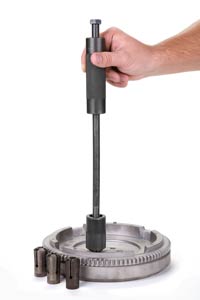I have a confession to make. I’m addicted to social media. That means I watch a lot of how-to videos on YouTube. Some of them are great, but some of them … not so much. I was watching one the other night when the guy used a pair of vise-grips to pull a dowel pin. I wanted to reach through the screen and rip those pliers out of his hands. Yes, he got the dowel out. But he also crushed it (and not in a good way). Let me be clear, you don’t use vise-grips to pull dowels. You use a dowel puller.
That’s what we’re going to talk about today. Dowel Pin Pullers. What your options are and how to use them.
There are a couple types of Dowel Pin Pullers, both of which incorporate a slide hammer.
 I’ll start with the Goodson Pin Pal Puller since it is the closest in design to vise-grips. Now, before you say I’m contradicting myself, you need to know that these locking pliers have been modified with special, replaceable jaws to stop you from destroying the dowel pins.
I’ll start with the Goodson Pin Pal Puller since it is the closest in design to vise-grips. Now, before you say I’m contradicting myself, you need to know that these locking pliers have been modified with special, replaceable jaws to stop you from destroying the dowel pins.
Before we look at how to use this tool, let’s talk safety. First of all, always use safety goggles or safety glasses when removing dowels with this or any other impact tool. Second, do not use this tool on hardened dowel pins; you’ll damage the tool. If you’re not sure if the pin is hardened, run a file across the top of the pin. If no metal is removed, don’t use this tool.
To remove dowel pins with the Pin Pal Puller, position the jaws over the pin to be removed and tighten them firmly. Do not over-tighten. You will be embedding the jaws into the pin slightly but you don’t want to crush the pin. Maintaining your grip on the pliers, grasp the slide hammer firmly with your other hand. Be sure your fingers are not between the top of the shaft and the top of the slide hammer (If you’ve ever slammed your finger in a door, you’ll understand why). Using short, fast upward strokes, impact the pin out.
If you plan to reuse the pin, you can file all of the high spots before reinstalling. In some cases, the pin is the same diameter from top to bottom so you can flip it over and reinstall the pin. No one will ever know you pulled the pin.
 Now let’s move on to the Goodson Dowel Puller. This tool is available as individual pieces or sets. This dowel removal method uses gripping collets and a slide hammer to do its work.
Now let’s move on to the Goodson Dowel Puller. This tool is available as individual pieces or sets. This dowel removal method uses gripping collets and a slide hammer to do its work.
The first step in using this puller is to select the correct size gripping collet. They are available with IDs from .1575” to .8000” so you’re pretty likely to find the size you need. We can’t stress this enough. Too small or too large of a collet won’t grasp the dowel pin sufficiently to work safely.
 To assemble this tool, you will put the slide hammer (GAO-2) onto the slide shaft (GAO-1), followed by the tightening sleeve (GAO-3). It is essential when installing the tightening sleeve on the shaft that the flared end is toward the collet end of the shaft. Last you will thread the collet onto the shaft as far as it will go.
To assemble this tool, you will put the slide hammer (GAO-2) onto the slide shaft (GAO-1), followed by the tightening sleeve (GAO-3). It is essential when installing the tightening sleeve on the shaft that the flared end is toward the collet end of the shaft. Last you will thread the collet onto the shaft as far as it will go.
Place the fully assembled tool over the dowel you want to remove. To lock the collet onto the dowel, grip the slide hammer and strike it against the tightening sleeve, forcing it over the top of collet compressing it tightly on the dowel. When you’re satisfied that the collet is tight on the dowel, use an upward motion with the slide hammer to pull the dowel. Again, be careful of your hand position so you don’t hurt yourself.
Now that the dowel is out, you need to release it from the collet. To do this, place the complete assembly on the removal basin (GAO-21) and sharply strike the top of the shaft with a hammer. This will release the tightening sleeve from the collet allowing you to access the dowel pin. You can now repeat the procedure on the remaining dowels.
For best results regardless of the dowel puller you are using it is important to only remove dowels when they are clean and dry. Oils, lubes, grease, etc. will get in the way of the tool’s operation and should be removed before trying to pull the dowels. Use a grease remover, carb cleaner or the like to remove any grease or oil then compressed air to dry the surface.
As always, if you have any questions about how to remove dowel pins, contact the Goodson Techxperts by email or phone (1-800-533-8010).
You might also like our Tech Lab Tuesday Video on Dowel Pin Pulling

